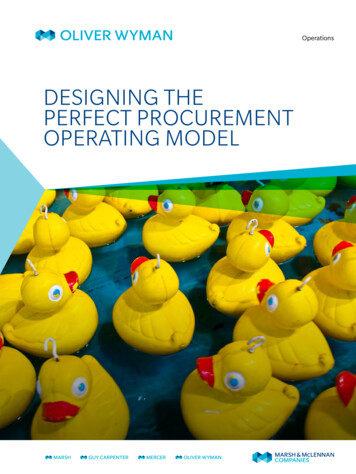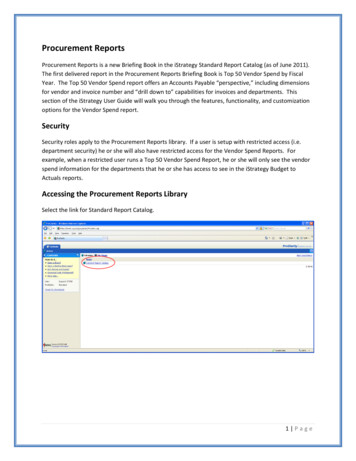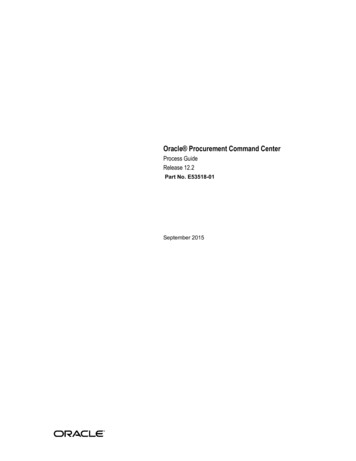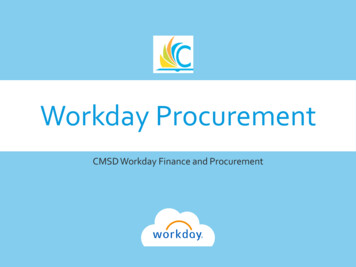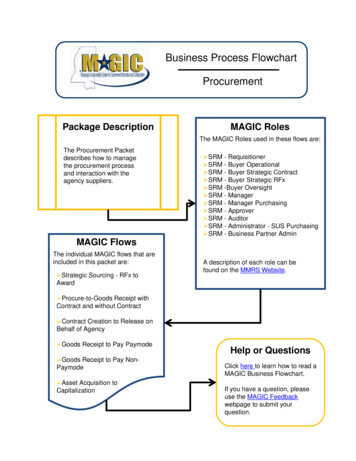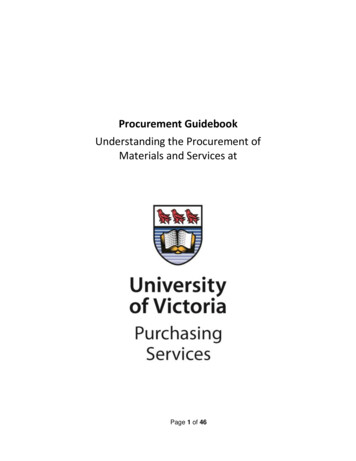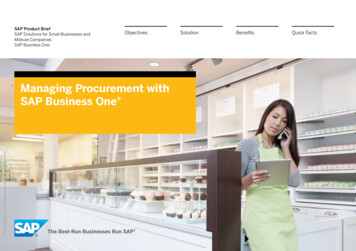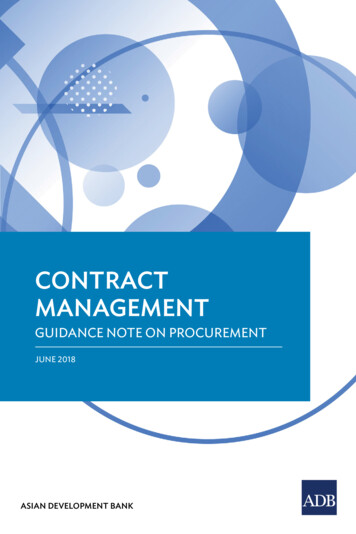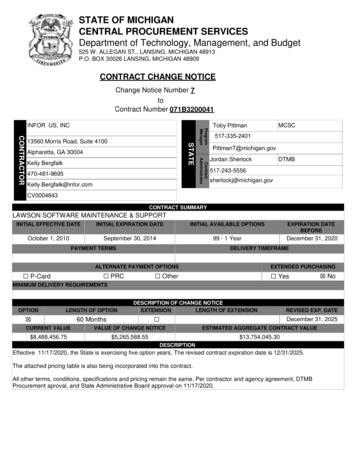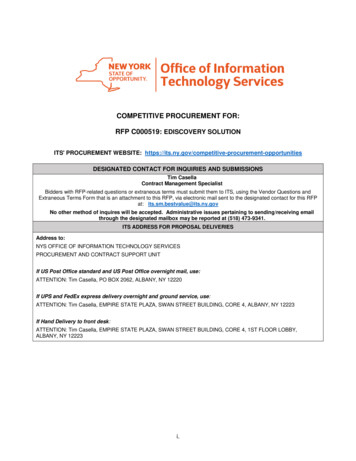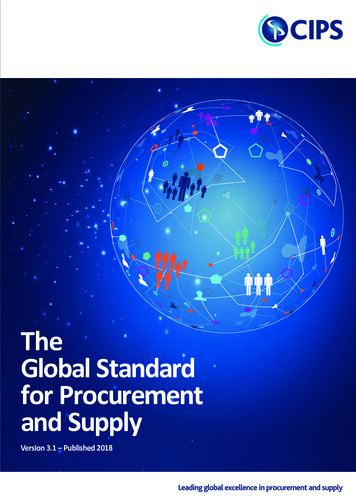
Transcription
TheGlobal Standardfor Procurementand SupplyVersion 3.1 – Published 2018
Thisversion containsthe updated Theme11 Ethics in Procurementand Supply published2018Updated theme 11Ethics in Procurement and SupplyThe Global Standard forProcurement and Supplyglobalstandard.cips.orgwww.cips.org
WelcomeNow in its third edition, the Global Standard forProcurement and Supply is a comprehensivecompetency framework that has beendeveloped through consultation with anextensive panel of 3000 practitioners andacademics drawn from across the world andrepresenting the diverse sectors and skill sets inherentwithin the profession.The final contribution of the panel to the annual review process ensures thatthe Standard remains up-to-date and relevant to the global procurement andsupply community. The Standard has been designed to help individuals andteams within organisations to understand the intrinsic value that good practicewill bring to their strategic goals and will serve as an aid to enhancingorganisational and personal performance.Building on the original content of the first 2 editions, the 2017 publication ofthe Standard reflects the expanding breadth of the profession as procurementleaders move towards delivering a broader influence across the entire valuechain. It also aims to support and protect standards within disciplines otherthan Procurement and Supply which may be involved in procurement activity,and to help organisations and individuals find and adopt more inclusive waysto ensure operational effectiveness.This Standard offers consistency in behaviours and improves the knowledge ofwhat excellence should look like in procurement and supply practice. Theseare the building blocks on which business can stand and succeed, and I urgeboards, CEOs and stakeholders to keep this free resource to hand tounderstand the value of the profession and its importance and sphere ofinfluence.CIPS is dedicated to leading the profession and to helping to evolveprocurement and supply professionalism for the future, regardless of whoundertakes the associated activity. This Standard is a key tenet of achieving thisgoal and is a vital resource if we are to ensure that procurement professionalshave the most relevant skills and knowledge to cope with volatile tradingenvironments, increasing complexity and the influence of informationtechnology.We should not underestimate the contribution of this Standard, and its role insupporting the CIPS vision of ‘Voice and Standard’; a vision that waschampioned by our sadly departed CEO, David Noble. We see this Standard asa significant part of David’s legacy not only to CIPS but to the profession as awhole – in David’s words “Our job is to equip our profession with theappropriate skills so that we can become guardians of the total enterprise”.This Standard is designed to be a key tenet of this challenge.What’s in this guide?04 The benefits of workingwith the Standard06 How the Standardis structured08 Using the Standard10 Using the Standard online11 CIPS Self-Assessment onlineINFRASTRUCTURE12 1. Position and Influence20 2. External Environment28 3. TechnologyPROCESS34 4. Spend Management42 5. Contracting49 6. SourcingPERFORMANCE58 7. Delivering Outcomes65 8. Metrics and67 8. MeasurementPEOPLE DEVELOPMENT71 9. Developing Teams and10. Individuals81 10. Developing Self and10. Personal Skills86 11. Ethics92 Contributors* Significant introductions or updates to this version include:the growing Position and Influence of the Profession, GlobalSourcing and understanding Market Conditions andassociated Tariffs and Trade Agreements, Data Security andthe adoption of Modern Technology, managing ContractGovernance and Regulatory Requirements as we seek agilityin response to business need, the increasing influence ofSupplier Relationship Management for Advanced LevelPractitioners, a rationalisation of Performance Metrics withan emphasis on Risk ManagementTo ensure you get the full benefits ofusing the Global Standard inProcurement and Supply we haveproduced a short guide about how youcan put the standard into practicewithin your organisation.Amanda O'BrienCIPS Group Professional Standards and Regulation Director03
Thebenefitsof working with the StandardOrganisations and individuals can identify and measure theirown performance levels in procurement and supply.Enhance organisational performanceThe Standard can be used to produce a detailed analysis by benchmarking procurementprofessionals against the knowledge and competencies. It identifies gaps in teamcapability and corresponding development needs, therefore enablingorganisations to: Contribute to significant savings by putting in place a procurement teamdevelopment plan. Put in place cost-effective, targeted training and development to plug gaps andmeet organisational needs. Build a cadre of well-trained and motivated staff, reducing turnover and makingassociated cost savings. Provide objective and measurable evidence of effective management in theprocurement function to senior managers, the board and shareholders. Influence and improve ethical practices in the supply chain throughimplementing ethical procurement policies and practices across an organisation.Enhancing personal performanceThe Standard can help to identify current competency levels and the knowledge andcapabilities needed to move onto the next career stage; this may be particularly usefulduring a performance review as it enables individuals to: Develop and agree a personal development plan to address the gaps identified inknowledge and capabilities. Implement the plan, including training, job shadowing and mentoringopportunities. Continue to monitor progress against the plan by referring back to the Standard toassess improvement.www.cips.org
Creating procurement job descriptions, advertising andperformance reviewsWithin each of the five levels of competency described in the Standard – Tactical,Operational, Managerial, Professional and Advanced Professional – we have provideddetailed sample job designs online, including which capabilities an individual shouldhave at each competency level, providing invaluable guidance in preparing jobadvertisements, writing job descriptions and carrying out performance reviews.This guide will help organisations and individualsto understand:How an organisation can use thestandard to improve procurementperformance.How an SME can use the Standardto support their procurementfunction and related activities.How an individual can use thestandard to improve theirperformance in the workplace.How to write job descriptions andadvertisements.05
How the Standard isstructuredThe Standard has been developed using five competency levels which have been identifiedfrom Tactical through to Advanced Professional. These levels represent the core skills andtasks that individuals should be capable of at each advancing stage of the profession. Theknowledge and capabilities can then be identified within the four pillars and eleventhemes for procurement and supply.1. The five levels of alOperationalTacticalApplies key tasksassociated with thework of procurementand supply.Provides advice andguidance to keystakeholders on theperformance oforganisationalprocedures andprocesses connectedwith procurement andsupply.Develops, improves andfulfils organisational andfunctional objectives inprocurementand supply.Formulates directionand advice, manageschange, and leads andinfluences both internaland externalstakeholders inprocurement andsupply.Leads procurementteams within anorganisation andinfluences the board toadopt leading-edgeprocurement strategiesand establish bestpractice. Influencessupply markets withinnovative sourcingsolutions.Buyer, ProcurementExecutive, ProcurementSpecialist, ContractingOfficer, Supply ChainAnalyst.Senior Buyer, ChiefBuyer, CategoryManager, ContractManager, ContractOfficer, LogisticsManager and SupplyChain Executive.Strategic ProcurementManager, SeniorCategory Manager,Supply Chain Manager,Head of Logistics andOperations Manager.Procurement Director,Supply Chain Director,Commercial Director,Head of Sourcing, ChiefProcurement Officer.Typical job rolesAdministrativeAssistant, PurchasingAssistant, ContractsAdministrator, StockController, InventoryPlanner, Assistant Buyerand Assistant ContractsOfficer.Use the Standard online globalstandard.cips.orgwww.cips.org
2. The four pillars and eleven themes for effective procurement and supply are further dividedinto individual segments of key knowledge and capability.Infrastructure1Position and Influence2External EnvironmentProcess49Developing Individuals and TeamsDelivering Outcomes8510Metrics and MeasurementContractingDeveloping Self and Personal Skills6TechnologyThis granularity of informationis key to identifying not only theprofessional knowledge andcapabilities required at thedifferent competency levels, butalso how they will be applied tothe practical workplace.7Spend thics in Procurement and Supply - ! %& (%& ( &( &( 00-- ""%% '"!'"! ! ! ( !%&#% !#%!! " " ! % %"!! !! # %"!!# ' % &&"")# !!&& 00.0.0 / ! %&%& ! ! &!"*!"*-#!!'''(( #"& ! % " " ( ( !!&& !" " " " ( ( !!&& !! !! !!%"" " !!''#!#!##!"!"!!!#!&!#'!!!''"&!"! ! !!'!!-! ! !* !# !!''!&&!!! ! #!##!!!##!" "# "! # !!##""###!'## ""!'!'#!'!#!'!&""" '!#&&!!!'%! '" "' "#!( # ' # "##''#'!!#&! !%!!#"'-!!!!! !!#!##(!#'2&#&# &(& ,( %* %!## "%&."%&. % ,%,% ()*()* % 2!##,''#0' !#! )2Knowledge!### *&2''(( ##'!#!!"#!"'% , '',(' -, ( ) ( 1 & '- ' ,1))%5 "'##!!!!%,''#0,''#0'!' !#! !#! )2)2&&!!"!! !#!##!!" !"' # " ! # '!!#!!'''!#!! !!'" '!##!%!#!" " !!'('( # !! !" !#%!"! !!##!"" &"&"-!# ! %' %- %%** 553535 4 % (()*)* % !%!% *%&.#%&.#! " '- - &, -! - % - -( ) ( 1 & '- ',1))%57 ,1))%5 ! "' & ' & '- ' %( ",/ ,(##(## !"* ! (!(! %& %& ! !"*"(##(## ') # "# " ( ( !& ! %(##%(## &" " ! % &) ( % &""!& "!& ('"!('"! & &')!&'"!% ! ! %(##%(## !%.%# " ! ( ! " # "# " ( ( !& ! %(##%(## '"!%!%.%#!&(! '"!%'"!% % "("(# " "&"& &"&" %&%& %, % & &!' % """"(!# "" %,!' & " !'"! ! ) ( % ! &" ! % '"!'"!'"!% & ! " ) .!! !!#4)% "' -! (% , '' -, ( ) ( 1 & '- ' ,1))%5"' ( '", /(', -( (%% 1 , ' (,, -! ( '", /('" !!! # !!###''#!"# *&2*&2Capabilities%# ! '!##!##4)% "' -! (% , ( ) ( 1 & '- ' ,1))%57 ,1))%5! "' & ' & '- ' %( ",/ , -( (%% 1 , ' (,, -! ( '", /('!- !(3/2 ) ( 1 & '-' ('- " 1-! !Use the Standard online www.cips.org/careers07
Using the Global Standardfor Procurement and SupplyThe Standard can be used to identify theperformance level of any individual, anywhere inthe world, who has a responsibility forprocurement full time or as part of their job roleincluding those with: Day-to-day responsibility for managing the procurement and supply function within anorganisation Strategic responsibility for ensuring the procurement and supply function complements andenhances the overall goals of the organisation No dedicated procurement function or a job role that encompasses other responsibilities andprofessional disciplines, such as administration, project support or finance.www.cips.org
By identifying individual competency levels, theStandard enables organisations to assess howefficiently, effectively and ethically procurement isbeing carried out.For private sector organisations.measuring procurement teams against theStandard can help to improve organisationalperformance, in terms of cost-effectiveness,compliance with ethical best practice andlegislation, and the reputation ofprocurement in itself with internal seniormanagers, board members, suppliers,customers and competitors.For public sector organisations.the Standard supports the cost-effectiveand efficient use of funds that is soimportant for public servants, governmentministers and members of the generalpublic, who are anxious to see ethical andgood use of public money.For individuals.measuring their own knowledge andcapabilities against the competency levels inthe Standard helps to identify developmentneeds, prepare for performance managementor reviews and plan a career developmentprogramme.Go online globalstandard.cips.org09
The Standard onlineDeveloping and planning a professional development journey couldn’t be easier.So far, over 75,000 professionals have used the Standard online to help with careerdevelopment planning.Global Standard for Procurement and SupplyStep1: Choose a LevelChoose a LevelGlobal Standard for Procurement and SupplyTacticalStep1: Choose a LevelOperationalChoose a al Standard forProcurement and SupplyGlobal Standard for Procurement and SupplyAdvanced professionalManagerialStep1: Choose a LevelStep1: Choose a LevelChoose a LevelProfessionalTacticalChoose a LevelOperationalAdvanced nalManagerialAdvanced professionalProfessionalAdvanced professionalGo to globalstandard.cips.org and follow the simple steps as illustrated below.Step 1Choose your level ofcompetencywww.cips.orgStep 2Choose a themeStep 3Choose a segmentfrom the themeStep 4Review your chosensegment and followthe related links toCIPS Knowledge, toolsand resources to helpfill your knowledgeand skills gap.
CIPSSelf-Assessment onlineIndividuals can align themselves against the Standard andplan their next career move.Using hundreds of live job roles advertised throughout the world, we’vecreated over 40 job profiles and mapped each role against the Standardthemes and levels. By assessing their own skills and knowledge it helpsindividuals to truly demonstrate their relevance and increase their valueto employers.Firstly, individuals explore the knowledge and capabilities identified inthe Standard then self-assess their own skills against the Standard,create their own profile and measure it against the other procurementjob profiles. At the end of the assessment a personalised report will helpto create a learning and development plan.Our online self-assessment is afree member resource thatprovides in-depth procurementknowledge and capabilityanalysis that identifies levels ofcompetency to inform futuredevelopment opportunities.To self-assess your level ofcompetency we recommend thatyou read through each themethen select your level based onyour understanding. You can thenreview your job profile to seeif it matches your actualcompetency level.Dr Gary Ramsden MCIPSCIPS Head of EducationDevelopment & Standards11
Pillar: Infrastructure StandardsTheme 1: Position and Influence of Procurement and SupplyThis theme helps individuals to recognise the contribution that effective procurement and supplycan make in organisations and in supply chains. The sphere of influence of procurement and supplychain personnel and functions should be promoted to all stakeholders, as the theme identifies goodpractices to achieve greater recognition by individuals and teams at an organisational level.TACTICAL COMPETENCY LEVELSegment 1.1 Understanding the Role of Procurement and Supplywww.cips.orgKnowledge: Will know and understand:Capabilities: Will be able to:The different terms that relate to procurement andsupply, supply chain management and logisticsExplain the roles of procurement and supply, supplychain management and logistics to colleagues andacross the organisationThe roles and benefits of procurement and supply inorganisationsExplain the roles and benefits of procurement and supplyin organisations to colleagues and across the organisationHow effective procurement impacts on profitability orcreating savings and efficiencies for the organisationDemonstrate how effective procurement can contributeto improving profitability, savings and efficiencies forthe organisationThe typical proportion of costs accounted for by theprocurement of goods and servicesDemonstrate and create the typical proportion of costsand budgets accounted for by the procurement ofgoods and services to colleagues and across theorganisationThe 5 rights that relate to procurement and supply Price/cost Quantity Quality Place TimeExplain how the 5 rights apply to commercialtransactions or agreementsInternal and external customers and their priorities forprocurement and supplyIdentify the different internal and external customersand recognise their different priorities for procurementand supplyThe main internal and external stakeholders inprocurement and supply and how they influenceprocurement and supply activitiesIdentify the stakeholders that can influence the work ofprocurement and supplyThe different objectives of a procurement and supplyfunctionPromote commitment amongst colleagues andstakeholders to achieve the objectives sought by aprocurement and supply functionThe creation of centralised, devolved and lead buyingstructures of procurement and supply functionsExplain to colleagues and across the organisation theadvantages and disadvantages that can be associatedwith centralised, devolved and lead buying structuresfor procurement and supplyThe tiers of a supply chainIdentify and assess the different organisations that areinvolved in the organisation's supply chainDifferent types of procurements such as: Capital and revenue purchases Products, services and construction works Direct and indirect Outsourcing and insourcingAdvise internal stakeholders on the different types ofpurchases that will typically be contracted for by theorganisation
TACTICAL COMPETENCY LEVELSegment 1.2 Apply Procedures that Regulate Procurement and SupplyKnowledge: Will know and understand:Capabilities: Will be able to:The documentation typically used in procurementand supply Requisitions Orders Delivery notes Invoices Other documentsAdvise colleagues on the different documents used inthe procurement and supply function and to personnelacross the organisationThe use of documented policies and procedures for thework of procurement and supply, including: The responsibilities for procurement Regulations relating to competition Levels of delegated authority Responsibilities for the stages of the sourcingprocess Invoice clearance and paymentEnsure that procedures are complied with by internalcustomers and stakeholdersThe need for approvals in the administration ofrequisitions, orders and invoicesWork to ensure that internal stakeholders obtainapprovals for the commitments to requisitions, ordersand invoicesEffective communication with suppliers and customers,both verbally and in writing to clarify requirements andto confirm understanding of requirementsUse clear and effective communication methods, bothverbal and written, when dealing with suppliers andcustomersHow to ensure that requisitions, orders and invoices areclear and correct and clarify requirements whencommunicating with stakeholdersWork to ensure that requisitions, orders and invoicesand other documentation relating to procurement andsupply are clear and correctThe use and roles of ethical codes in procurement andsupplyEncourage the behaviour and actions of colleagues andother stakeholders to be in keeping with ethical codesfor procurement and supplyThe principles of corporate governance that apply toprocurement and supplyExplain the main principles of corporate governancethat apply to the organisation's procurement andsupply function13
OPERATIONAL COMPETENCY LEVELSegment 1.3 Advising Stakeholders on the Role of Procurement and Supplywww.cips.orgKnowledge: Will know and understand:Capabilities: Will be able to:The inputs that internal and external stakeholders canmake in procurement and supplyResearch, assess and prioritise stakeholders'requirements to ensure value for money outcome andrisk assured solutions are achievedThe conflicts of interest that can exist in the work ofprocurement and supply and how to deal with themDeal effectively with conflict that may arise withstakeholders to ensure the objectives of procurementand supply are prioritisedThe use of documented policies and procedures for thework of procurement and supply, including: The responsibilities for procurement Regulations relating to competition Levels of delegated authority Responsibilities for the stages of the sourcingprocess Invoice clearance and paymentAdvise stakeholders on the interpretation of proceduresfor procurement and supplyProcedures for the separation and segregation of dutiesAdvise internal stakeholders of the procedures thatapply to the separation and segregation of duties inperforming roles in procurement to prevent fraud anderrorThe use of codes of ethics in procurement and supplyMonitor the work of internal stakeholders to ensurethat the codes of ethics in procurement and supply areupheldComparisons of centralised, devolved and hybridstructures for carrying out procurement and supplyactivitiesExplain to colleagues and other internal stakeholdersthe different structures that can be adopted forprocurement and supply activities while recognisingtheir strengths and weaknessesThe use and purposes of financial budgets that impacton procurement and supplyAdvise internal stakeholders on procurement andsupply issues that impact on the creation andmanagement of financial budgets
OPERATIONAL COMPETENCY LEVELSegment 1.4 Improving the Role of Procurement and Supply within the OrganisationKnowledge: Will know and understand:Capabilities: Will be able to:The design of typical organisational structures and theposition of procurement of supply in the organisationalstructurePromote the position and potential influence ofprocurement and supply in the organisational structureThe main influences that shape organisationalbehaviourIdentify the different behaviours to internalstakeholders adopted by individuals, groups andorganisations and use appropriate approaches toenhance effectivenessThe different behavioural characteristics of individualsthat can impact on their management while in theprocurement and supply chain functionRecognise the different behavioural characteristics ofindividuals and how these differences should shapemanagement styles appropriate to different situationsThe motivation of individuals involved in theprocurement and supply functionMotivate and support colleagues and other internalstakeholders to achieve their commitment to the workundertaken in procurement and supplyThe use of documented policies and procedures for thework of procurement and supply, including: the responsibilities for procurement regulations relating to competition levels of delegated authority responsibilities for the stages of the sourcing process invoice clearance and paymentContribute to the development and use of documentedpolicies and procedures for the procurement andsupply function and ensure their application bycolleagues and stakeholders15
MANAGERIAL COMPETENCY LEVELSegment 1.5 Developing Supply Chain Managementwww.cips.orgKnowledge: Will know and understand:Capabilities: Will be able to:Sources of competitive advantage such as low cost,sources of differential advantage such as innovation,product/service range, brand image and customer careEnsure that the procurement and supply functionsupports the achievement of the organisation's sourcesof competitive advantageThe added value to organisations that can be achievedthrough effective supply chain management by: Reducing prices and total costs Improving quality Reducing time to market and achieving deliveries torequired timescales Encouraging innovation Reducing risk and supply chain vulnerability Promoting sustainable procurementCreate plans with stakeholders to improve supply chainmanagement and add organisational valueThe development of integrated supply chains, supplynetworks and supply chain managementLiaise with stakeholders to develop supply chains,supply networks and supply chain managementThe importance of collaborative and competitivestrategies for improving supply chain management andhow they differ from each otherDevelop appropriate strategies and plans for improvingsupply chain management with stakeholders andpromote their useThe main risks that can impact on supply chains andhow they can be mitigatedWork with stakeholders to mitigate or manage risks thatcan impact on supply chainsStandards and legislation that apply to bribery,corruption and fraud in organisations, their applicationand why this is importantWork with stakeholders to eliminate corruption andfraud in supply chains
PROFESSIONAL COMPETENCY LEVELSegment 1.6 Leading the Procurement and Supply FunctionKnowledge: Will know and understand:Capabilities: Will be able to:The use of vision statements to improve procurementand supply chain managementCreate and implement an appropriate vision for theorganisation that promotes procurement and supplychain management both internally and with externalstakeholdersThe roles of a leader and the activities of leadership inthe procurement and supply functionDemonstrate effective leadership skills withstakeholders by developing, communicating andpromoting the purpose, values and vision of improvedprocurement and supply chain management across theorganisation and with suppliersHow to assess the sources of power with internal andexternal stakeholders and why this is importantSteer the procurement and supply chain functionthrough difficulties and challenge, recognising thesources of power with internal and externalstakeholders and managing the impact on theorganisation and its supply chainsLeadership behaviours and stylesDemonstrate leadership behaviours and styles thatpromote procurement and supply chain managementboth internally and with external stakeholdersThe distinction between transformational andinspirational leadership skillsSteer the procurement and supply chain function byadopting appropriate leadership skills to promoteprocurement and supply chain management bothinternally and with stakeholdersDifficulties and challenges to the function fromstakeholdersPromote the benefits of the procurement and supplychain function to stakeholders dealing with difficultiesand challengesTechniques for stakeholder mapping including primary,secondary and key stakeholder classificationsEvaluate stakeholders and execute plans to achieveeffective procurement and supply chain managementwith stakeholdersThe use of communication plans to enhanceprocurement and supply chain managementCreate communication plans to achieve the buy-in tothe procurement plan by internal and externalstakeholdersHow to develop expenditure approval levelsDevelop policy for procurement and supply expenditureapproval levelsThe impact of policy, legislative and regulatoryrequirements on the supply chainCommunicate an understanding of policy, legislativeand regulatory requirements affecting the supply chainto stakeholdersThe application of procedures and governance affectingprocurement and supply chain managementDevelop and implement relevant procedures andgovernance for effective procurement and supply chainmanagement with stakeholders17
PROFESSIONAL COMPETENCY LEVELSegment 1.7 Developing the Strategy for Procurement and Supply within the Organisationwww.cips.orgKnowledge: Will know and understand:Capabilities: Will be able to:The main characteristics of strategic decisions inorganisationsUse and apply strategic decision-making techniques toformulate improvements to procurement and supplychain managementThe alignment of corporate, business andfunctional levels of strategy in organisationsContribute to the development and implementation offunctional, business unit and corporate strategiesDifferent approaches to the development of strategy inorganisations such as: Rational planning Emergent and logical incrementalismEvaluate the different approaches to strategydevelopment and ensure that relevant issues are fedinto strategy development and implementation for theprocurement and supply chain functionand are aligned with the needs of the organisationThe impact of globalisation on the development ofstrategy for effective Procurement and SupplyDesign and implement strategies for the procurementand supply chain function that take account of theimpact of globalisationThe contributions that the procurement and/or supplychain functions can make to the achievement ofcorporate objectivesPromote the contributions that the procurement orsupply chain functions can make to achieving corporateobjectives across the organisation, with stakeholdersand with the supply chainCorporate governance for Procurement and SupplyWork with internal stakeholders to establish anappropriate and effective process and framework thatsupports corporate governanceThe main methods for achieving cultural acceptance ofstrategies in organisationsDevelop and implement plans and actions withstakeholders to achieve the cultural acceptance ofstrategies that reflect effective procurement and supplychain managementHow change management processes can addressresistance to change from stakeholdersEvaluate how change management processes canaddress resistance to change and develop a changemanagement strategy that deals with resistance tochange
ADVANCED PROFESSIONAL COMPETENCY LEVELSegment 1.8 Building Strategic Relationships with StakeholdersKnowledge: Will know and understand:Capabilities: Will be able to:Consultants, clients and the consulting processUndertake an assessment of the expectations of clientsand be able to manage expectations through acontrolled processThe impact of policy, legislation and regulation on theprocurement and supply chain management functionPromote and apply relevant policy, legislation andregulation affecting procurement and supply chainmanagementThe differences between consulting and counsellingskills and why consulting skills are critical to driving andinfluencing organisational changeIdentify situations in interactions with stakeholders toprovide consulting advice or a counselling approachApproaches to managing strategic stakeholderrelationshipsPromote and develop effective strategic stakeholderrelationships through the use of appropriateorganisational processes, systems and practicesThe range of
and supply. Typical job roles Administrative Assistant, Purchasing Assistant, Contracts Administrator, Stock Controller, Inventory Planner, Assistant Buyer and Assistant Contracts Officer. Buyer, Procurement Executive, Procurement Specialist, Contracting Officer, Supply Chain Analyst.
